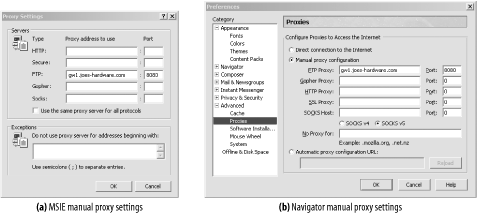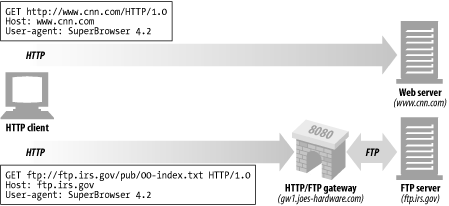Protocol Gateways
You can direct HTTP traffic to gateways the same way you direct traffic to proxies. Most commonly, you explicitly configure browsers to use gateways, intercept traffic transparently, or configure gateways as surrogates (reverse proxies).
Figure 8-3 shows the dialog boxes used to configure a browser to use server-side FTP gateways. In the configuration shown, the browser is configured to use gw1.joes-hardware.comas an HTTP/FTP gateway for all FTP URLs. Instead of sending FTP commands to an FTP server, the browser will send HTTP commands to the HTTP/FTP gateway gw1.joes-hardware.com on port 8080.

Figure 8-3. Configuring an HTTP/FTP gateway
The result of this gateway configuration is shown in Figure 8-4. Normal HTTP traffic is unaffected; it continues to flow directly to origin servers. But requests for FTP URLs are sent to the gateway gw1.joes-hardware.com within HTTP requests. The gateway performs the FTP transactions on the client’s behalf and carries results back to the client by HTTP.

Figure 8-4. Browsers can configure particular protocols to use particular gateways
The following sections describe common kinds of gateways: server protocol converters, server-side security gateways, client-side security gateways, and application servers.
HTTP/*: Server-Side Web Gateways ...
Get HTTP: The Definitive Guide now with the O’Reilly learning platform.
O’Reilly members experience books, live events, courses curated by job role, and more from O’Reilly and nearly 200 top publishers.

